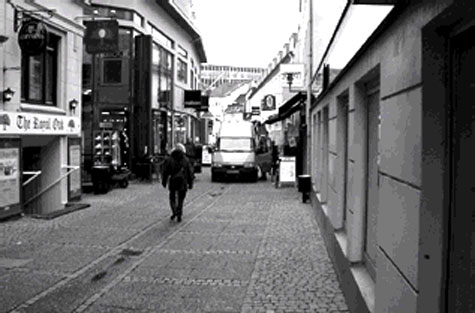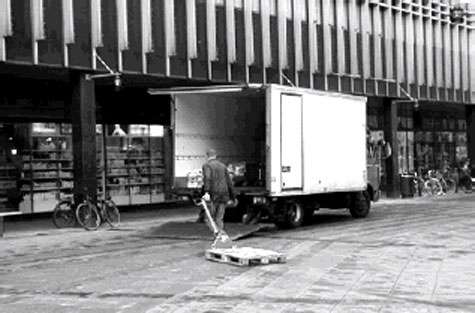Varedistribuering i Århus City
Summary| Data Collection |
| Partners |
| Impacts |
| Main problems |
| Improvement measures |
| Possible solutions |
The traffic related problems in Danish urban areas are increasing due to the growth in the motorised traffic. Freight transport in urban areas make up a significant share of the traffic and hence of the total environmental impact. Several analyses have shown that a large share of the urban freight transport is environmentally inefficient, indicating a large need for rationalisation.
Data Collection
On this background the Municipality of Aarhus has – supported by the City Traffic Project of The Danish Environmental Protection Agency – carried out a project with the purpose to map out in detail the freight distribution in specific streets and to establish suggestions for a rationalisation of the freight distribution.
The survey comprised a registration of the physical conditions, a license plate based survey, interviews with drivers and a registration of deliveries to each shop. As a supplement to these street surveys, interviews with manufacturers, distributors and shopkeepers were also carried out.
One of the most significant results of the surveys was a remarkable surplus of capacity in relation to the transported amounts of goods. In the area of the survey the daily amount of delivered goods was about 13.6 tons. For this purpose a number of 333 trucks was used with a total tonnage of 2000 tons. Theoretically, the goods could be delivered by only 16 small trucks.
Partners
The central area in a major city is characterised by a lot of people attracted by functions in a small geographical area. There are shops, restaurants and other functions, attracting many customers and demanding constant supplies of goods. At the same time, there is a wish of the society to carry out the necessary transport activities as efficient as possible, in order to minimise the environmental impacts of the transport.
In the actual project four main parties have been identified as having essential interests in the freight distribution. These are the society (national authorities), the city, the distributors and the shopkeepers. Several other parties are influenced by the distribution but do not have the same opportunities to change it, e.g. suppliers, drivers, shop customers and residents in the area. The interested parties have different aims and interests; hence a rationalisation of the freight istribution requires co-operation and common understanding among the various groups of partners.
Impacts
The most dominant negative impacts of the freight distribution can be summarised under the headlines energy consumption, environmental impacts and economy. These are directly influencing the interested parties mentioned above.
Further, a number of impacts are influencing working environment, safety and traffic relations. These impacts are mainly influencing the other parties, who are not active partners in the freight distribution.
The main interest of the society is the global environment, i.e. a reduction of the CO2 emission. Therefore, on a national level the main focus is on the energy consumption. The municipality on the other hand emphasises the local environment, whilst the other partners are mainly focusing on economic aspects.
The project has been aimed at the primary interested parties. Therefore the other interested parties and their impacts are only mentioned briefly.
Main problems
The surveys of the freight distribution revealed several conditions influencing the efficiency of the freight distribution. The major problems are:
| too many trucks are used | |
| the utilisation of the trucks is too small | |
| many trucks have to park against the regulations | |
| the receiver's conditions are bad | |
| the time consumption per stop is high | |
| the time restrictions for deliveries in pedestrian zones are too strict |
On the other hand some prejudices have been broken down. Contrary to the expected results the trucks have shown to be rather new, the engine running at idle speed is limited and the trucks do not come from far away.
Improvement measures
Previous projects regarding urban freight transport have mainly been focusing on the distributors as they carry out the transport and thus have the best opportunities to change the conditions. The distributors, however, have often emphasised that the other parties involved should play a more active role to solve the problems related to the distribution.
Each partner has a series of improvement measures as listed below:
The society's measures
The society's improvement measures are established on a national level, comprising
national legislation and setting up the framework for local legislation. The most
important measures are the following:
| legislation | |
| tax regulations | |
| norms for emissions | |
| campaigns | |
| support to demonstration projects |
The city's measures
The city – in this case the Municipality of Aarhus – has a series of
measures related to local legislation and planning. In brief, the city's measures can be
described as follows:
| physical layout of street areas | |
| conditions for parking | |
| local traffic regulations | |
| local campaigns | |
| demonstration projects |
The distributors' measures
The distributors are the most active part in the goods distribution and therefore they
also have the widest range of means:
| transport planning | |
| transport coordination | |
| use of a freight terminal | |
| age of trucks | |
| size of trucks | |
| engine technical devices | |
| unloading devices and other devices | |
| education of drivers | |
| environmental management | |
| alternative means of transport |
The shopkeepers' measures
Experience indicates that the main interest of the shopkeepers is frequent deliveries
of goods, whereas they have only a very limited interest in the organisation of the
freight distribution. This issue, however, does not mean that the shopkeepers can not
participate in a rationalisation of the distribution.

The shopkeepers' improvement measures are:
| improved physical conditions for receiving goods | |
| earlier opening hours for receiving goods | |
| leave key at neighbour shop | |
| collective receiving of goods for several shops |
The main conclusion of the survey is that there are to many vans and trucks in the City area in relation to the amounts of goods. The solution is to reduce the number of trucks, while the amounts of goods remain the same, which implies a higher use of capacity for each truck. The Danish Environmental Protection Agency and the Municipality of Aarhus have selected the following possible concrete solutions for reaching this goal:
| "environmental zone" | |
| co-ordination of the freight distribution on a voluntary basis | |
| tenders for freight distribution |
"Environmental zone"
An "environmental zone" is a limited geographical area, in which special
restrictions apply in order to reduce the environmental impacts from the traffic. In this
solution, an "environmental zone" is suggested, in which trucks of more than 2
tons gross weight are only allowed, if they fulfil the Euro 2 norm, have a gross weight of
less than 12 tons and they have a use of capacity of at least 60%.
This solution requires a certain amount of control and administration, but experiences gained from a similar solution in Copenhagen might be useful. An "environmental zone" reduces the number of trucks in the zone and thus provides a little improvement with regard to air pollution.
Transport coordination on a voluntary basis
Another possibility to consolidate the goods on fewer trucks is that distributors
establish a collective transport of goods. This might be carried out by an independent
company administrating the distribution. The members are shopkeepers and distributors, but
not the municipality, as the company is to be run on commercial marketterms.
The company is established as a pure administration company without own trucks or terminals. These services are to be provided by existing companies.
Results from a project in Aalborg, financed by the Danish Transport Council, indicate that significant reductions of emissions can be obtained through a coordination of transport on a voluntary basis. Tenders for freight distribution.
As the third and last solution, it is suggested that the shopkeepers invite fortenders for all freight distribution in a limited area of the city. The distribution company, which wins the tender, is obligated to take care of distribution of all kinds of goods in the area, using environment friendly vehicles. This solution implies that the producers of goods accept their goods to be picked up and delivered by the distribution company. The shopkeepers must accept to have fewer deliveries with larger consignments.

It must be possible for other distributors to obtain a permission under special circumstances, for example when delivering express goods. It is assumed that this solution will have the most significant environmental impacts. The three solutions are summarised as follows:
Table 1. Look here!
Summary of solutions